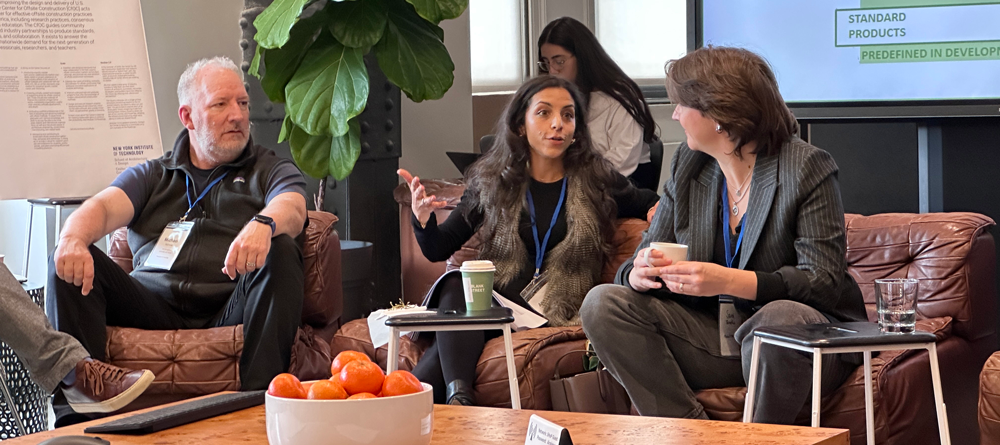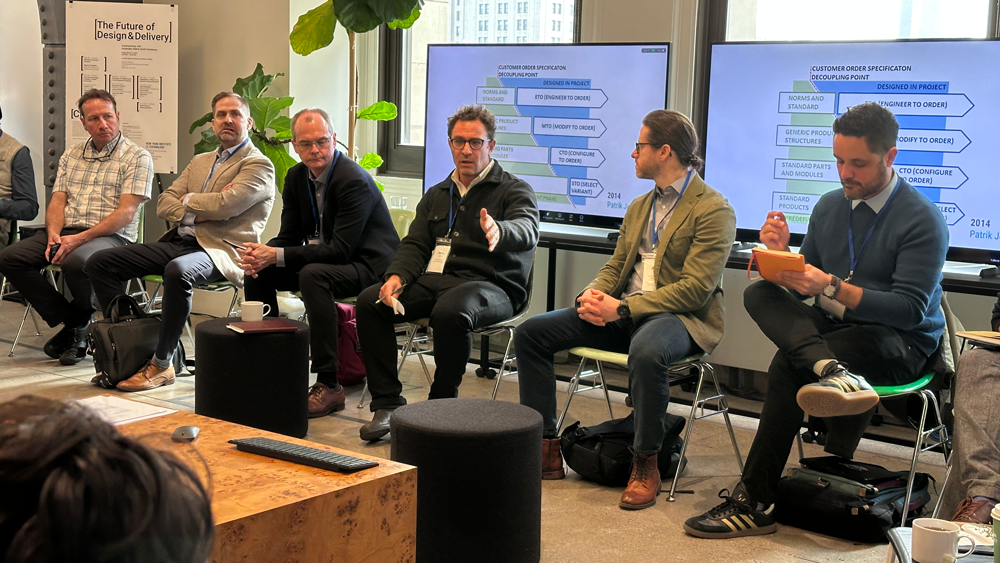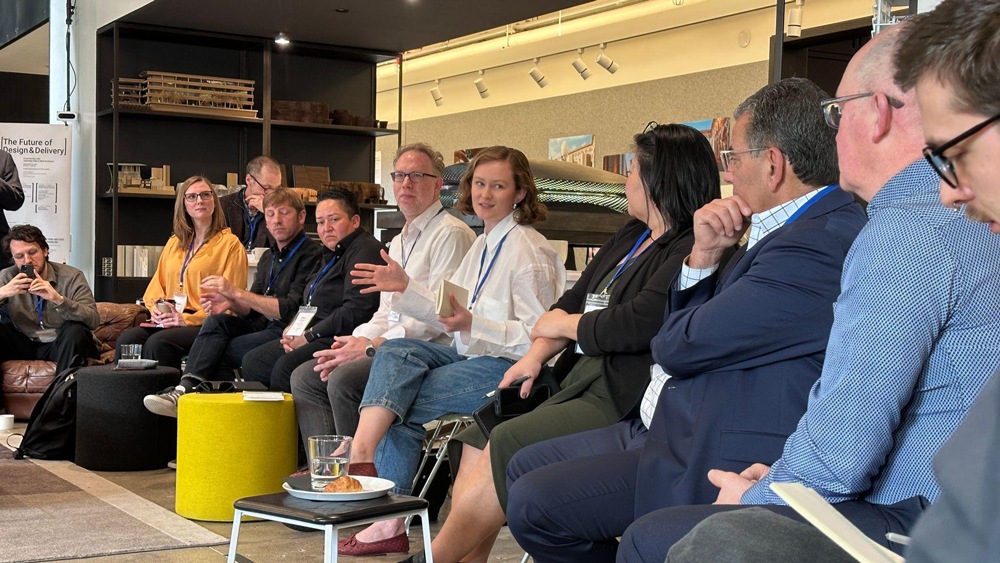Future of Design and Delivery Symposium – 2025
The Center for Offsite Construction (CfOC) at New York Tech hosts the annual Future of Design and Delivery Symposium as a dedicated forum for reviewing and discussing the Center’s active projects, research roadmap, and current agreements.
This gathering invites industry leaders, researchers, and practitioners to provide feedback, share insights, and contribute to advancing modular construction practices. By fostering collaboration and inviting new voices to engage with our work, the CfOC aims to drive innovation and practical solutions for housing challenges.
2025 Symposium – Hosted at SHoP with Assembly OSM

Below, you’ll find summaries of the 2025 symposium’s three discussions, organized around three contracts inked by the CfOC in Q1 of 2025.

“Future of Design Thinking”
Core Partnership
Offsite Design & Delivery Program Accreditation with the Modular Building Institute
Discussion Leaders
This conversation explored the CfOC’s partnership to create the first accredited degree in Offsite Design & Delivery—and with it, a new path to professional licensure.
From licensing pathways and curriculum design to gaps in site knowledge and manufacturing fluency, we asked symposium attendees:
- What should the next generation of offsite leaders know?
- How do we build accreditation that mirrors real-world complexity?
- Can we close the disconnect between architects, fabricators, and GCs?
Key Takeaways
- Education must balance book smarts and street smarts.
- Internships and site exposure are non-negotiable.
- This isn’t just for architects—it’s interdisciplinary by necessity.
- A leadership vacuum in offsite education is ready to be filled.
- We need a consistent, U.S.-relevant curriculum rooted in lessons learned.
It was clear from the onset that the CfOC is not designing a silver bullet. We’re designing an ecosystem of next-generation thinkers. We ask our guests “Let’s build the MS-ODD together,” and we’re excited to see some of the responses – some quoted below.
Feedback
“It is important that the senior research fellows are in the process of carefully mapping each (Master of Design & Development) course to the entire real estate development value chain. It is necessary to ensure the accredited courses reflect the entire process, given the gravity of the scope. Everything from how a developer thinks and determines when to engage offsite players, to standardization, to updated ways we need to manage construction sites, to how entitlement/city planning operation for modular, to financing-to-sale… are important pieces of the equation. It’s great to see that most of this is on the CfOC’s Research Roadmap, but it is hard to break silos across disciplines in a piecemeal fashion. The right organizational step is to map courses to the entire value chain to avoid any oversight.” – Apoorva Pasricha (Cloud Apartments)
– Apoorva Pasricha (COO, Cloud Apartments)
This is great! But how can we overcome the half-decade wait for Master of Design & Delivery graduates?! What could be offered in the meantime for the industry?”
– Geoff Lynch, (Studio Director, Government & Defense Northeast Lead, Gensler)
“A lot of these themes are what we discuss on the Future of the Practice Committee (AIA). If this degree program had been available years ago, I would have pursued it enthusiastically! This vision for a future professional is a new standard for what an Architect should be going forward because this new system-level thinking will plug the profession into a higher-level managerial role. It offers a 21st C. pathway to the historic master builder.”
– John Mikesh (Digital Innovator and Material Designer)
“This is super exciting. I think one of the areas that gets too little focus when we are discussing modular is the business model of both the modular manufacturer and our customers (real estate developers). I love the degree updates making a required Real Estate Finance / Construction Loan class. It’s even exciting to think beyond that, to other financial and business model-focused electives supplement this core knowledge. The industry needs to make sure that everyone going into modular (even non-business roles) understands the unique nuances of draws/requisitions/construction loans – because that impacts the technical side of product design, supplier selection, material selection, and overall incentive system of our customers.”
-Andrew Stanisforth (CEO, Assembly OSM)

Future of Collaborations
Core Partnership
CfOC’s ANSI Accreditation and Modular Standard Co-development Agreement with the International Code Council (ICC)
Discussion Leaders
In the symposium’s second discussion, Future of Collaborations in Offsite Construction, we explored how offsite construction can scale only if its players collaborate across legal, financial, manufacturing, and design silos.
The CfOC asked:
- What does it take to shift from Engineer-to-Order (ETO) to Configure-to-Order (CTO)?
- How can contracts, code, and insurance evolve to support productized construction?
- Can the industry standardize without becoming generic?
…and the lively discussion was all over the place.
Key Takeaways
- The bottlenecks aren’t just technical—they’re legal, financial, and cultural.
- Modular success depends on aligning stakeholders early—from investors to inspectors.
- Data-sharing and liability clarity are essential to unlocking true collaboration.
- Inspection could be productized and standardized—if we design for it.
- We need new proving grounds, new roles, and new rules to move from one-off builds to true product platforms.
At the conclusion of the discussion, a basic understanding was crystal clear: this group is not just making buildings, we’re building the infrastructure for a whole new industry.
The feedback the CfOC got (after the discussion) was just as exciting at the 40-person roundtable.
Feedback
“What great news – that folks are working on a location and funding for New York State testing. Our industry needs to reward innovation in development in ways like this! The symposium highlighted that each represented company needs developers to take a programmatic approach to new methods, so it’s exciting to think this can be incorporated into any version of the State’s vision for the NY Lab. From our experience, programmatic initiatives (at the city/state level) are a key way to depoliticize such an effort. It would be a first-in-the-nation opportunity to see the state dedicate multiple parcels of land to become a part of a state lab, and within each parcel, the state incentivizes testing/validating a specific hypothesis that it collects data around. This is the best way to demonstrate success – with case studies pointing developers to innovation that has indeed been tested.”
– Apoorva Pasricha (Cloud Apartments)
“The problem we’re solving for is a better requirement for simplicity. All these systems have to work together for functionality. We want to standardize the interfaces between all our products to reach that goal. We’ve seen folks try to enforce that vision by imposing it within an entire ecosystem that they own. That’s top-heavy and difficult to keep profitable. The CfOC is trying to create a decentralized ecosystem, where stakeholders can tackle assembly constraints and limitations as like-minded teams – not employees. This is the way to a vibrant US offsite industry.”
– Matt Ford (New York Tech School of Architecture and Design)

Future Marketplace for Offsite Construction
Core Partnership
The CfOC’s agreement with Good Developments Group (GDG) to create the Configure-to-Order Housing Alliance
Discussion leaders [h4]
In our final discussion, the CfOC staff and guests focused on how standardized interfaces—like a “USB for buildings”—could accelerate the modular industry and unlock a true configure-to-order (CTO) marketplace. The CfOC is entering an agreement with the ICC to write that standard with our ANSI accreditation.
This will quickly change many firms’ path to market. As a result, we also announced an agreement the CfOC entered with Good Developments Group— to found the CTO Housing Alliance and build a platform for CTO-capable firms to find (and deliver) multifamily projects faster.
We asked:
- How do we engineer compatibility across manufacturers and trades?
- What makes a modular product viable at scale—technically, financially, and culturally?
- Who needs to be in the room to write the standards?
Key Takeaways
- Interface standards can reduce soft costs, increase reuse, and support global scaling.
- Building a CTO ecosystem means aligning engineering, finance, manufacturing, and inspection.
- Collaboration needs to start early—with investors, cities, GCs, and universities at the table.
- Modular isn’t one-size-fits-all, but strategic partnerships can shape repeatable models.
- It’s not just about raising capital—it’s about building a stable, mission-aligned market.
We believe that this is how you build a valuable marketplace: not with hype, but with commonly held, opt-in standards. The CfOC was as excited as ever when one guest agreed: “Let’s write the specs for the future of housing.”
Feedback
“The real opportunity here is creating an open marketplace where manufacturers can design to shared standards and become suppliers across a wide range of projects—not just locked into one platform or partner. That kind of interoperability builds resiliency into their business model, expands their customer base, and helps keep factories running consistently. Standardized interfaces unlock choice—for both builders and suppliers—and that’s what makes a healthy, sustainable offsite industry.”
– Matt Ford (New York Tech School of Architecture and Design)
“It was an honor to be a part of what you guys are building. You have a knack for finding those folks who are the most open to change and bringing them all into the same room. The energy was inspiring and I’m glad I got to be a part of it.”
– Aaron Small (ReFrame Systems)